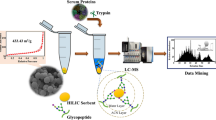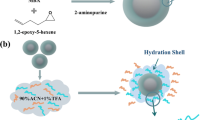Abstract
New approaches for the engineering of well-defined, pore modality, and multi-chemical functionality nanocomposites are crucial to generate the next generation of functional materials with recoverable and easy preparation properties. Here, a catalyst and heat free polymerization reaction is exploited and fabricated zwitterionic system around magnetic nanoparticles. N-aminoethyl piperazine propane sulfonate (AEPPS) and dopamine (DA) are introduced as the zwitterionic system, which provided abundant zwitterionic groups (NH2, SO3−, N+) and strong adhesion and various oxidation state properties. And that, the zwitterionic engineering will assemble between AEPPS and DA whereby Schiff base formation or Michael type addition. Whereafter, a series of sophisticated array of microscopic, spectroscopic, and structure techniques verify the formation of highly crosslinking internal zwitterionic architectures, well-defined core–shell structure, and better porosity. The zwitterionic structure–function relationships and striking porous structure are explored in a multi-interaction adsorption assay. The adsorption capacity of the magnetic nanocomposites was 1065.8 mg/g. And that, the system exhibited with hydrophilic-hydrophobic activity towards glycoprotein and better performance to bioactive protein (Ig-G) isolation form human whole blood sample. The synergistic enhancement interaction in hydrophilic target enrichment, easy preparation, and soft substrate properties of the AEPPS-DA zwitterionic materials make them intriguing candidates for sustainable biomedical loading and chromatographic separation.





Similar content being viewed by others
References
Luo H, Zhou X, Ellingford C, et al. Interface design for high energy density polymer nanocomposites [J]. Chem Soc Rev. 2019;48(16):4424–65.
Yang Q, Dong Y, Qiu Y, et al. Design of functional magnetic nanocomposites for bioseparation [J]. Colloids Surf B: Biointerfaces. 2020;191: 111014.
Sun Y, Zheng L, Yang Y, et al. Metal-organic framework nanocarriers for drug delivery in biomedical applications [J]. Nanomicro Lett. 2020;12(1):1–29.
Cargnello M. Colloidal nanocrystals as building blocks for well-defined heterogeneous catalysts [J]. Chem Mater. 2019;31(3):576–96.
Zhu XY, Yu JY, Yan YC, et al. One-pot alkali cutting-assisted synthesis of fluorescence tunable amino-functionalized graphene quantum dots as a multifunctional nanosensor for sensing of pH and tannic acid [J]. Talanta. 2020;236: 122874.
Wu Q, Lee J, Sun J, et al. In situ direct growth of graphene/hexagonal boron nitride heterostructure on SiO2 substrate without metal catalyst [J]. Carbon. 2018;138:76–80.
Song C, Yan Q, Zhang T, et al. Enhanced polysulfide conversion through metal oxide-support interaction in MnOx/MXene [J]. Chem Eng J. 2021;420: 130452.
Ri SH, Bi F, Guan A, et al. Manganese-cerium composite oxide pyrolyzed from metal organic framework supporting palladium nanoparticles for efficient toluene oxidation [J]. J Colloid Interface Sci. 2021;586:836–46.
Hai X, Y Li, Zhu C, et al. DNA-based label-free electrochemical biosensors: from principles to applications [J]. TrAC Trends in Analytical Chemistry. 2020;133(2): 116098.
Guo ZY, Zhang C, Jiao RW, et al. Construction of metal hydrate-based amorphous magnetic nanosheets for enhanced protein enrichment and immobilization [J]. ACS Appl Mater Interfaces. 2021;13(31):37915–23.
Lu Y, Lin J, Wang L, et al. Self-assembly of copolymer micelles: higher-level assembly for constructing hierarchical structure [J]. Chem Rev. 2020;120(9):4111–40.
Feng L, Wang KY, Powell J, et al. Controllable synthesis of metal-organic frameworks and their hierarchical assemblies [J]. Matter. 2019;1(4):801–24.
Mariani S, La Mattina AA, Paghi A, et al. Maskless preparation of spatially-resolved plasmonic nanoparticles on polydimethylsiloxane via in situ fluoride-assisted synthesis [J]. Adv Funct Mater. 2021;31(26):2100774.
Hu G, Albrow-Owen T, Jin X, et al. Black phosphorus ink formulation for inkjet printing of optoelectronics and photonics [J]. Nat Commun. 2017;8(1):1–10.
Kim Y, Zhu J, Yeom B, et al. Stretchable nanoparticle conductors with self-organized conductive pathways [J]. Nature. 2013;500(7460):59–63.
Zhu XY, Li T, Hai X, et al. A nanozyme-based colorimetric sensor array as electronic tongue for thiols discrimination and disease identification [J]. Biosens Bioelectron. 2022;213: 114438.
Zou Y, Zhou X, Ma J, et al. Recent advances in amphiphilic block copolymer templated mesoporous metal-based materials: assembly engineering and applications [J]. Chem Soc Rev. 2020;49(4):1173–208.
Tan KW, Wiesner U. Block copolymer self-assembly directed hierarchically structured materials from nonequilibrium transient laser heating [J]. Macromolecules. 2019;52(2):395–409.
Guo Z, Huang G, Zhang C, et al. Amphipathic engineering of magnetic composites reinforced with ion-copolymer-activated protein-bioconjugate functionalized surface [J]. Mater Chem Front. 2022;6(2):237–44.
Han J, Liu K, Chang R, et al. Photooxidase-mimicking nanovesicles with superior photocatalytic activity and stability based on amphiphilic amino acid and phthalocyanine co-assembly [J]. Angew Chem. 2019;131(7):2022–6.
Guo ZY, Hai X, Wang YT, et al. Core-corona magnetic nanospheres functionalized with zwitterionic polymer ionic liquid for highly selective isolation of glycoprotein [J]. Biomacromol. 2018;19(1):53–61.
Buzolic JJ, Li H, Aman ZM, et al. Self-assembled nanostructure induced in deep eutectic solvents via an amphiphilic hydrogen bond donor [J]. J Colloid Interface Sci. 2022;616:121–8.
Ji YL, Gu BX, Xie SJ, et al. Superfast water transport zwitterionic polymeric nanofluidic membrane reinforced by metal–organic frameworks [J]. Adv Mater. 2021;33(38):2102292.
Meng QW, Ge Q. Enhancing chlorine resistance and water permeability during forward osmosis separation using superhydrophilic materials with conjugated systems [J]. ACS Appl Mater Interfaces. 2020;12(31):35393–402.
Narkar AR, Kelley JD, Pinnaratip R, et al. Effect of ionic functional groups on the oxidation state and interfacial binding property of catechol-based adhesive [J]. Biomacromol. 2017;19(5):1416–24.
An QF, Sun WD, Zhao Q, et al. Study on a novel nanofiltration membrane prepared by interfacial polymerization with zwitterionic amine monomers [J]. J Membr Sci. 2013;431:171–9.
Guo ZY, Zhang Y, Zhang DD, et al. Magnetic nanospheres encapsulated by mesoporous copper oxide shell for selective isolation of hemoglobin [J]. ACS Appl Mater Interfaces. 2016;8(43):29734–41.
Guo Z, Zhang D, Song S, et al. Complexes of magnetic nanospheres with amphiprotic polymer-Zn systems for the selective isolation of lactoferrin [J]. J Mater Chem B. 2018;6(35):5596–603.
Jiang W, Fischer G, Girmay Y, et al. Zwitterionic stationary phase with covalently bonded phosphorylcholine type polymer grafts and its applicability to separation of peptides in the hydrophilic interaction liquid chromatography mode [J]. J Chromatogr A. 2006;1127(1–2):82–91.
Guo PF, Wang XM, Wang MM, et al. Two-dimensional titanate-based zwitterionic hydrophilic sorbent for the selective adsorption of glycoproteins [J]. Anal Chim Acta. 2019;1088:72–8.
Fu D, Liu Y, Shen A, et al. Preparation of glutathione-functionalized zwitterionic silica material for efficient enrichment of sialylated N-glycopeptides [J]. Anal Bioanal Chem. 2019;411(18):4131–40.
Zhang W, Jiang L, Wang D, et al. Preparation of copper tetra (N-carbonylacrylic) aminephthalocyanine functionalized zwitterionic-polymer monolith for highly specific capture of glycopeptides [J]. Anal Bioanal Chem. 2018;410(25):6653–61.
Petralia L M C, van Diepen A, Lokker L A, et al. Mass spectrometric and glycan microarray-based characterization of the filarial nematode Brugia malayi glycome reveals anionic and zwitterionic glycan antigens [J]. Mol Cell Proteomics, 2022: 100201.
Hu X, Chen Q, Zhang DD, et al. Pyridine boronic acid-polyoxometalate based porous hybrid for efficient depletion of high abundant glycoproteins in plasma [J]. J Mater Chem B. 2018;6(48):8196–203.
Acknowledgements
The authors appreciate financial support from the National Natural Science Foundation of China (Grant No. 22004105), and special project of the Marine and Fishery Department of Xiamen (No. 19CZB001HJ03). The education and research project of the young and middle-aged teachers of Fujian Province (JAT 200880).
Author information
Authors and Affiliations
Corresponding author
Ethics declarations
Conflict of interest
The authors declare no competing interests.
Additional information
Publisher's note
Springer Nature remains neutral with regard to jurisdictional claims in published maps and institutional affiliations.
Published in the topical collection featuring Sustainability in (Bio-)Analytical Chemistry.
Supplementary Information
Below is the link to the electronic supplementary material.
Rights and permissions
About this article
Cite this article
Guo, ZY., Yao, QH., Zheng, WH. et al. Highly crosslinking core–shell magnetic nanocomposites based catalyst and heat free polymerization for isolation of glycoprotein. Anal Bioanal Chem 414, 6393–6402 (2022). https://doi.org/10.1007/s00216-022-04202-4
Received:
Revised:
Accepted:
Published:
Issue Date:
DOI: https://doi.org/10.1007/s00216-022-04202-4




